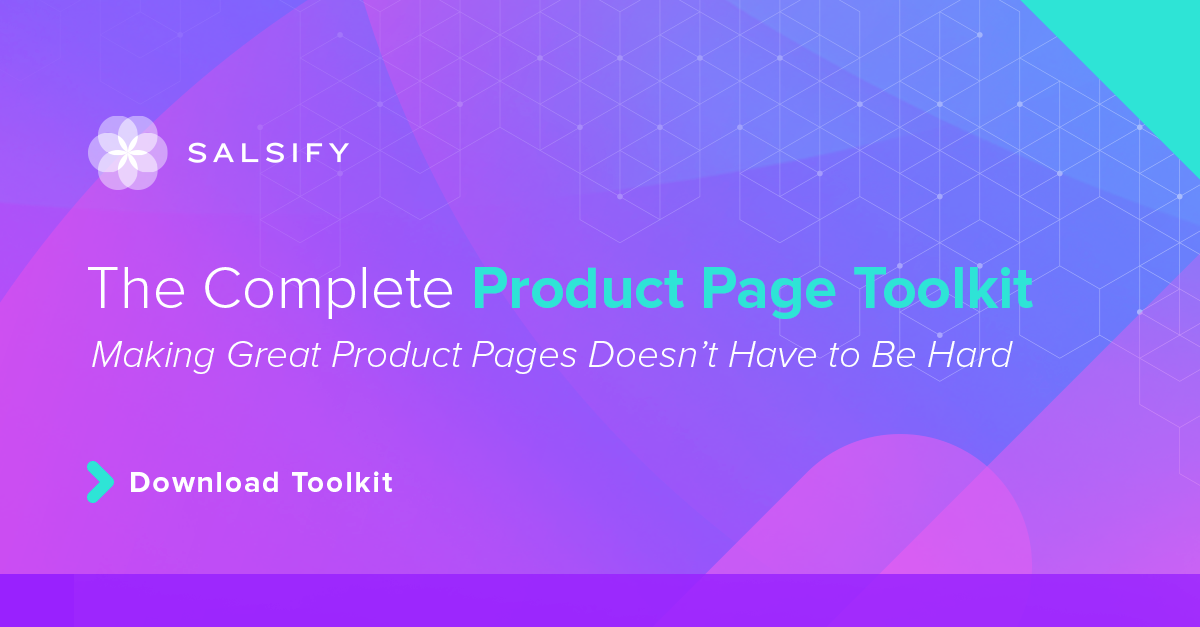

The Complete Product Page Toolkit
Making great product pages doesn't have to be hard. Download our toolkit, and start building winning shopping experiences.
DOWNLOAD TOOLKITPIM
Manage all product content in one central system of record.
Syndication
Easily syndicate product content to every consumer touch point.
Enhanced Content
Enrich product pages with below-the-fold content and rich media.
Intelligence Suite
Bring AI-powered capabilities directly into your Salsify workflows.
Grocery Accelerator
Leverage the first-ever category-wide PXM accelerator in the grocery industry.
GDSN Data Pool
Synchronize standard supply chain, marketing, and ecommerce attributes globally.
Digital Shelf Analytics
Continuously optimize your organization’s product content syndication.
Catalog Sites
Share secure, on-brand, and always up-to-date digital product catalogs.
Automation and AI
Automate business processes and enhance Salsify workflows with AI.
PXM Platform, Integrations, and APIs
Integrate the PXM platform with the rest of your enterprise systems architecture.
Supplier Onboarding
Accelerate supplier onboarding while ensuring your schema requirements are met.
Product Listing
Sell products faster with Product Listing.
Content Enrichment
Increase online conversions with Content Enrichment.
Automation
Save time and increase operational efficiency with retail automation.
SXM Platform, Integrations, and APIs
Integrate the SXM platform with the rest of your enterprise systems architecture.
Syndication Network
Automate how you exchange product content data to the digital shelf.
Enhanced Content Network
Turn product pages into product experiences with Enhanced Content.
Commerce Platform Integrations
Create winning product experiences everywhere shoppers are, including on owned sites.
GDSN Data Pool
Synchronize standard supply chain, marketing, and ecommerce attributes globally.
Open Catalog
Connect to the digital shelf faster with an open, standardized, and free product catalog.
Resources
Resource Library
Explore our ecommerce resources to get everything you need to win on the digital shelf.
Blog
Read our blog to get actionable insights for navigating changing markets and industry demands.
Webinars
Watch our on-demand ecommerce webinars to gain expert advice and tips from our community of industry leaders.
Customer Blog
Gain the latest tips, industry trends, and actionable ecommerce insights.
Knowledge Base
Investigate our knowledge base to build your Salsify skills and understanding.
API
Examine our comprehensive API and webhook guides to start working with Salsify quickly.

Download the report to get expert insights, consumer research, and top industry trends.

If someone wanted to purchase a power tool 20 years ago, they’d drive to their local hardware store or big-box retailer. Then, they’d carefully review their options, chat through specs and warranty details with a sales associate, inspect product features, and compare prices before making a selection.
Even if a consumer spent weeks or months considering their purchase, much of the buyer’s journey still took place within the store. But times have changed, and the future of shopping for tools looks much different.
Today, most buyers begin their process with a search engine query. They research products online, read reviews, and narrow brand choices before comparing prices among multiple sellers. While some consumers still complete their purchases in-store, the majority of the journey happens online — on the digital shelf.
As a tool brand manufacturer, it can be challenging to keep up with consumer habits. Ensuring all the retailers you work with provide a positive in-store experience to your buyers isn’t enough — especially given that more and more purchases will be digitally influenced in the future.
So how can you engage buyers online, across the digital shelf, and transform them into brand advocates? Here’s how five well-known tool brands are successfully winning over modern buyers.
When John Deere was founded in 1837, no one could have predicted how far the brand would advance. Today, the iconic equipment manufacturer is delving into artificial intelligence (AI) and data-driven initiatives to help its buyers meet their needs.
But instead of discussing their machines’ highly sophisticated technology, much of the brand’s consumer-targeted content focuses on what its audience really cares about: the products’ comfort, quality, and reliability.
Whether a prospective customer is shopping on The Home Depot, Lowe’s, or John Deere’s website, they’ll be served the same message through engaging videos and thorough descriptions.
Milwaukee Tool has an easily identifiable brand and maintains a cohesive identity across its entire web presence — starting with its website and expanding to third-party retailers.
Additionally, because this brand manufacturer recognizes the future of shopping is mobile-first, the brand created a powerful app where customers can build their own digital inventory of tools and, for contractors managing teams, assign them to workers on a job site.
Milwaukee Tool has built a robust social media presence, leveraging platforms like Instagram to connect with current and prospective customers and participate in audience conversations.
There’s a reason Black & Decker has thrived for more than a century: The company consistently adapts to changing markets and consumer expectations.
To ensure today’s consumers enjoy a cohesive experience as they hop from channel to channel, Black & Decker leverages enhanced content — high-quality product images, well-produced videos, and highly detailed descriptions — across all retailers. The brand’s inspirational how-to project content published on its site, as well as its social media accounts, help keep buyers engaged long after they’ve completed a purchase.
Unlike brands that strive to work with as many retailers as possible, Ryobi is sold exclusively at The Home Depot in the U.S., as well as a few online retailers like Amazon. Regardless of where you find the company’s products, though, most consumers are sure to recognize this popular Japanese brand — and not just because its product descriptions are remarkably consistent.
A little over a decade ago, the brand changed its product color from dark blue to an edgy, impossible-to-miss lime green, and rolled out a user-friendly, interchangeable battery to incentivize brand loyalty.
But Ryobi knows real power in the online world comes in the form of five-star reviews, which is why its team offers customers a chance to win a The Home Depot gift card for reviewing products online. Amassing several hundred reviews on each product helps cement Ryobi’s credibility as a trusted brand.
When someone is investing in a power tool, there’s no such thing as too much information. After all, if you fail to provide the specs and data a consumer wants to see, they’re likely to begin searching elsewhere — and that’s when you risk losing them to the competition.
When you shop for DeWalt Tools products, you won’t run into this issue.
The brand’s online presence, across its own website and retailers, you’ll find a plethora of specific product specs, features, warranty information, and more. The brand also includes a wide assortment of high-resolution images so shoppers can carefully inspect the finer details of each item — just as they might scrutinize a product in-store. This gives potential customers everything they need to make a decision.
Captivating buyers and keeping them engaged throughout the buyer’s journey is becoming more difficult in today’s crowded marketplace.
But there are three key things these brands do to boost their success.
Also called A+ content or rich media, enhanced brand content is essential to capturing buyers’ attention today — and for the foreseeable future of shopping. Creating high-quality assets, such as aesthetically pleasing imagery, 360-degree product views, useful videos, and detailed bullets, and sharing them across all platforms and retailers, will help bring the in-store experience online.
These brands all tailor their marketing to their buyers’ specific pain points and challenges and seek to help them overcome those obstacles head-on. When your messaging focuses more on your buyer than your brand, you’re more likely to keep them interested and outpace your competition.
When you keep your content and brand identity cohesive across all channels and platforms, it supports your credibility and helps establish trust in your brand.
The way shoppers interact with tool brands, and their path to purchase, has shifted dramatically — and this evolution isn’t likely to slow anytime soon. By implementing enhanced content to accelerate performance on third-party retail sites, focusing on solving specific buyer challenges, and keeping your brand consistent on and off the web, you’ll be well-prepared for whatever the future has in store.

Making great product pages doesn't have to be hard. Download our toolkit, and start building winning shopping experiences.
DOWNLOAD TOOLKITStanding out on the digital shelf starts with access to the latest industry content. Subscribe to Below the Fold, our monthly content newsletter, and join other commerce leaders.